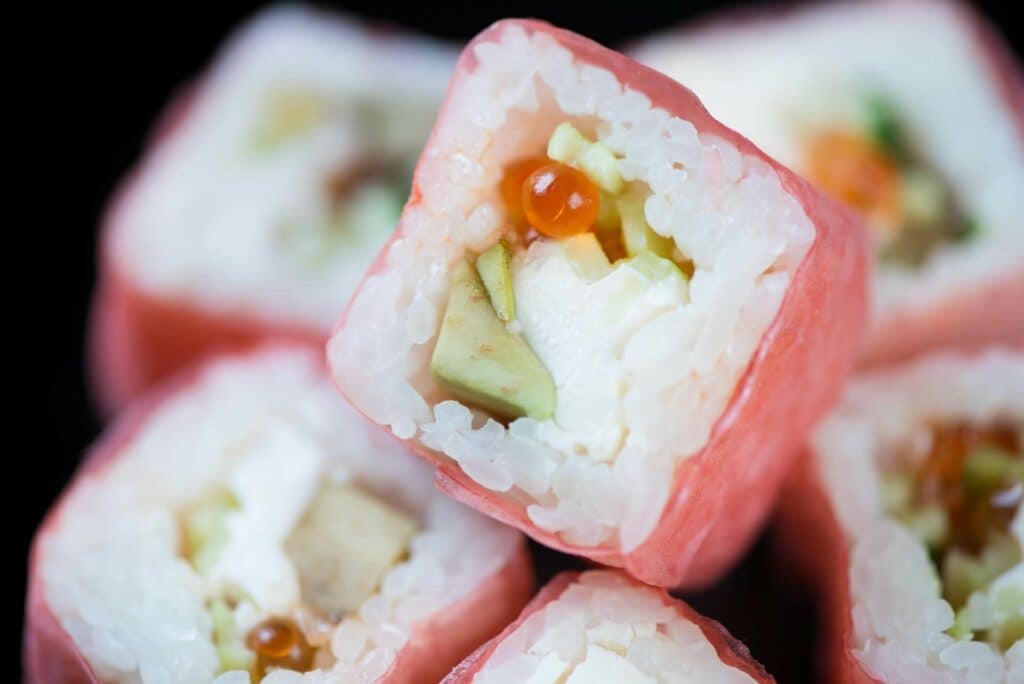Sushi is well known to be primarily made with raw fish, rice, and vegetables. If you have never tried sushi before, you’re probably wondering – Does sushi taste like fish? Well, the answer mostly depends on the type of sushi you are eating, among other factors. Let’s find out how sushi tastes.
So, does sushi taste like fish? The taste of fish is not necessarily detectable in sushi, as the rice and other fillings can overpower the flavor. However, there are some types of sushi that use raw fish, and in those cases the taste of fish is more pronounced.


If you don’t like the taste of fish, you probably won’t enjoy eating sushi with fish. However, there are still a few other options you can try out.
Does Sushi Taste Like Fish? What Is the Taste of Sushi?
Sushi is primarily made out of raw fish. The most commonly used fish is tuna, salmon, or eel. When served, this fish must be fresh, which means the smell of the fish shouldn’t be strong. Tuna and salmon have a very mild and neutral flavor, so you shouldn’t feel any strong fishy odor.
It is also usually served with all kinds of different vegetables and vinegar rice. And on the side, you will get soy sauce, wasabi, and pickled ginger.
Maki Rolls, Nigiri, Sashimi, and Temaki All Have Different Flavors
As you probably know, sushi can come in many forms, most of which involve some sort of fish or seafood as the main ingredient aside from rice. Since there are several different types, the taste of the fish can be stronger in some than in others.
Let’s take a look at how different sushi tastes:
- Maki Rolls – Both Maki and Uramaki rolls are made with similar ingredients, and these are one of the most popular forms of sushi. They are made from fish, vegetables, rice, and seaweed. When you eat the rolls, you should be able to taste the fish (mildly), vegetables, and the sauce that is inside the rolls.
- Nigiri – This is the oldest method of making sushi. It is made with pressed vinegar rice and fish topping on top of that rice. When fish is fresh, and of good quality, the taste should mostly remind you of the sea. If your nigiri is made from top-quality bluefin tuna, the most expensive tuna in the world, the taste shouldn’t be anything like fish at all. Fresh tuna and salmon must have a really mild sea taste and texture of the most tender meat.
- Temaki – Made with nori (seaweed) rice and fish, this type of sushi is similar to rolls with only a difference in shape. Temaki is made with fish, vegetables, and rice that are all wrapped in seaweed in a CONUS shape. The fish that is used here is sashimi-grade tuna that is mixed with Japanese mayo and other ingredients. The dominant taste will be from the mayo and sweetness of the tuna. This type of sushi can also be made with cooked fish or canned tuna, so the taste will be similar to a tuna sandwich.
- Sashimi – This sushi is made from raw fish and nothing else, so naturally, the taste of the fish will be most dominant. Still, with this sushi, you shouldn’t feel a strong fishy flavor, but the opposite. The taste of fresh tuna or salmon is mild, natural, and sweet, while the texture should be gentle and not chewy.
There Are Many Different Types of Sushi You Can Try Out That Come Without Raw Fish
If you don’t like any kind of fish but like to enjoy sushi, you can eat different kinds of sushi that are not made with raw fish.
For those who like seafood, there are plenty of rolls made with crab or shrimp, such as Californian or shrimp tempura rolls. You can also order nigiri sushi which is topped with shrimp tail that is always cooked.
For those who can not eat seafood, there are plenty of vegetarian versions of sushi to eat, which usually come in the form of regular or temaki rolls.
Some of the most popular ones are shiitake mushroom nigiri, nasu nigiri, avocado nigiri, and kappa maki.

Should I Eat Sushi That Has a Fishy Taste?
As you can see, sushi should not have any kind of strong flavor, so if you bought sushi that has a strong fishy taste, we are sorry to disappoint you, but that sushi has gone bad and should be thrown away immediately.
There is no ingredient in the world that will get you to the ER faster than raw fish and seafood that has gone bad. Maybe you will not end up in the hospital, but your night will not be pleasant.
If you are not sure about the smell of the fish, don’t risk it and just throw it away. However, the stronger smell and taste is not the only thing you can look out for.
To give you a better idea, here are some of the most common ingredients in sushi and how they look when they are fresh and when they are not:
| Fish | Tuna | Salmon |
| Color when fresh | Deeper red color to bright pink | Bright pink to light orange color |
| Color when spoiled | Green, black, and brown | Gray, pale and discolored |
| Smell when fresh | Mild sea smell | Mild scent |
| Smell when spoiled | Sour, fishy smell | Fishy smell |
| Texture when fresh | Firm and soft, depending on the quality of the tuna | Firm texture that bounces back when touched |
| Texture when spoiled | Soft, spongy, and leaky texture | Soft and your finger dips inside of the flesh |
Always Check if Your Sushi Is Good
Whether you eat sushi at a restaurant or you buy it in the supermarket, it’s important to smell it and inspect other features such as color or shape before you eat it.
If you are not sure whether the fish is fresh or not, it is always better to assume it isn’t.